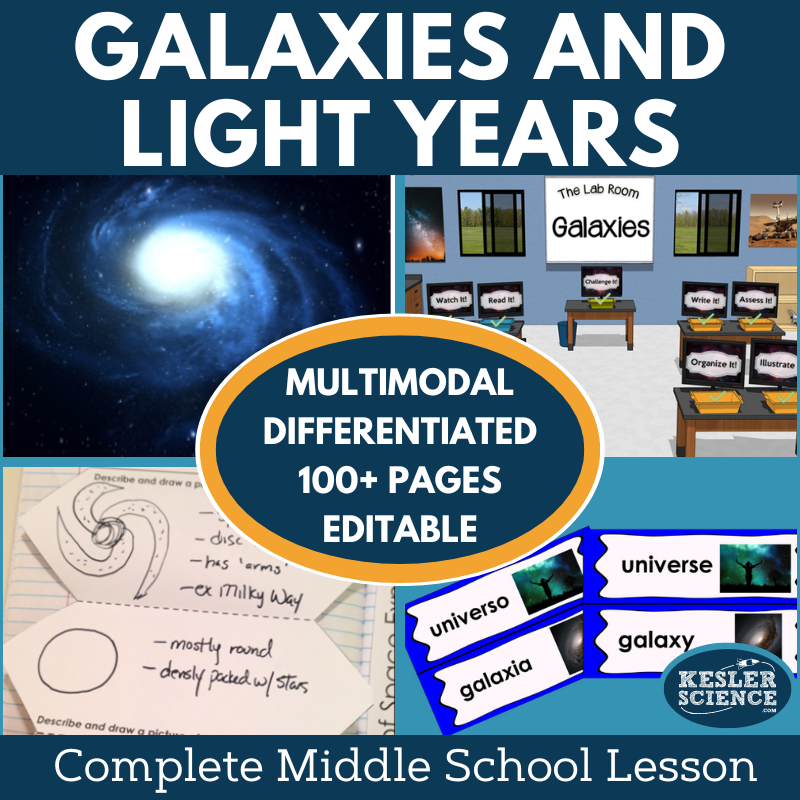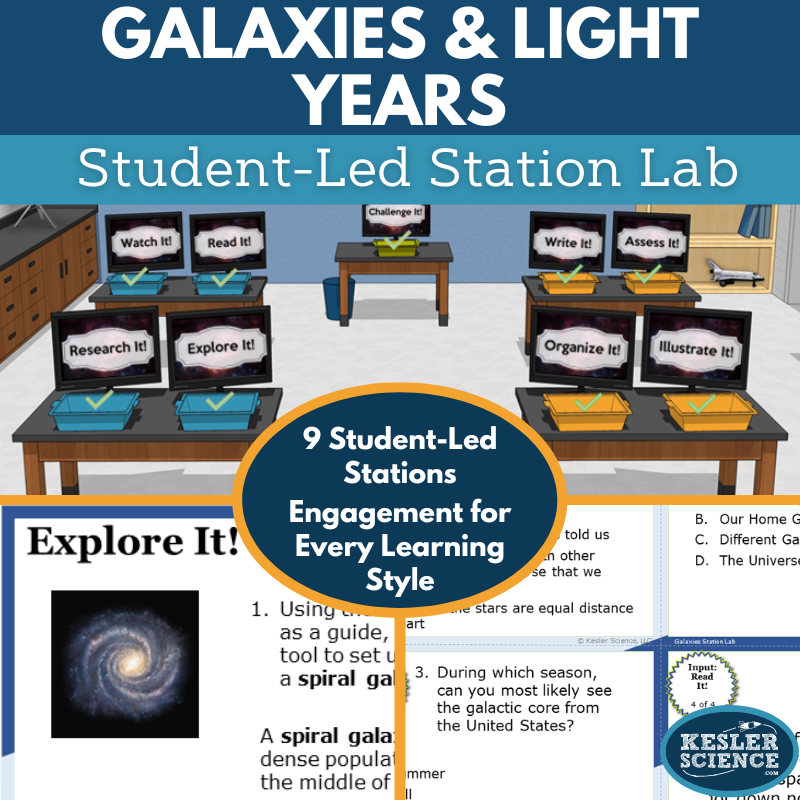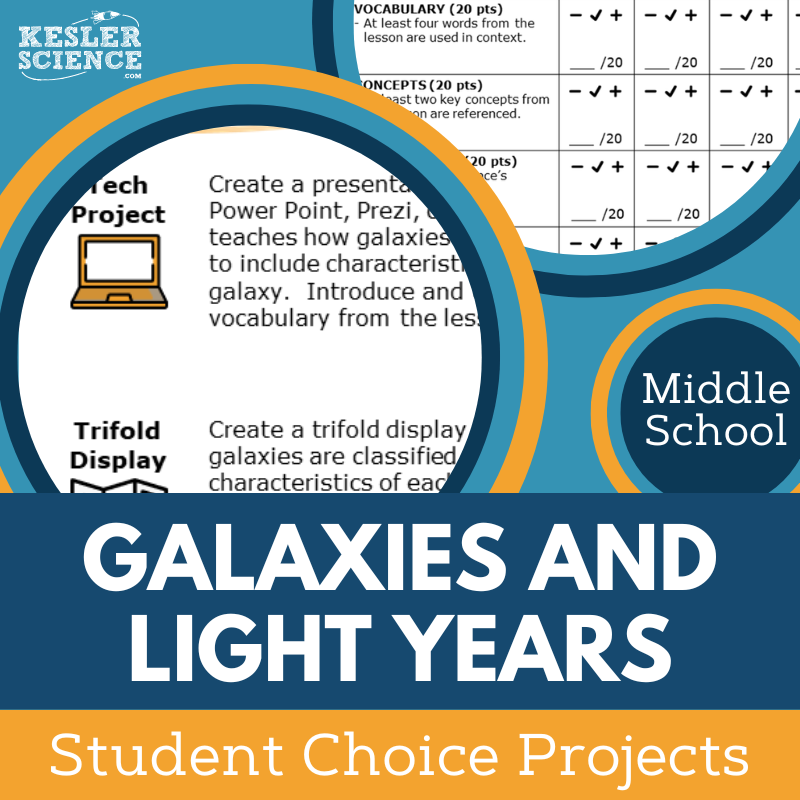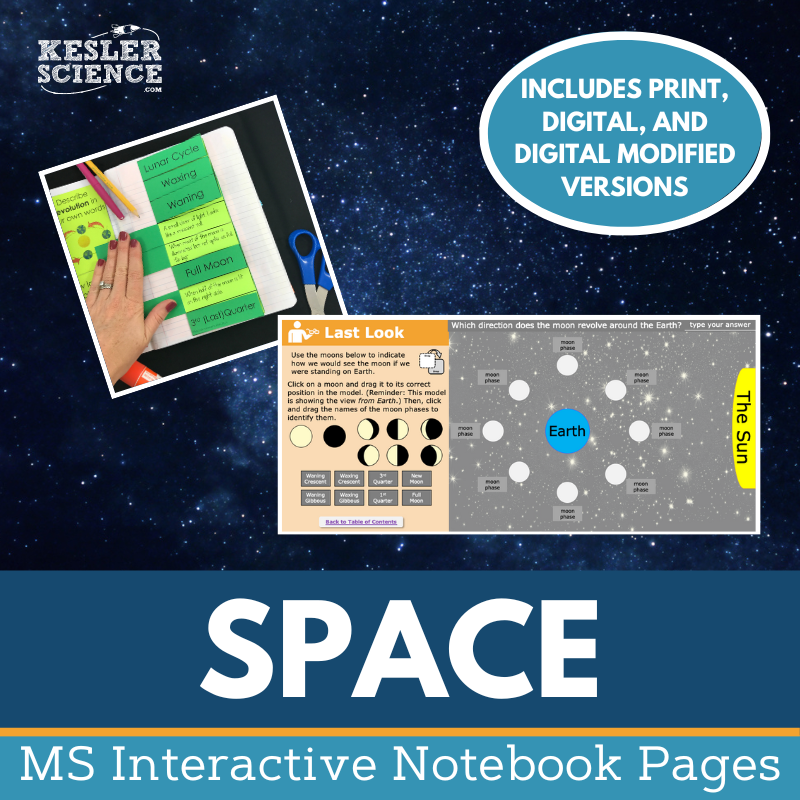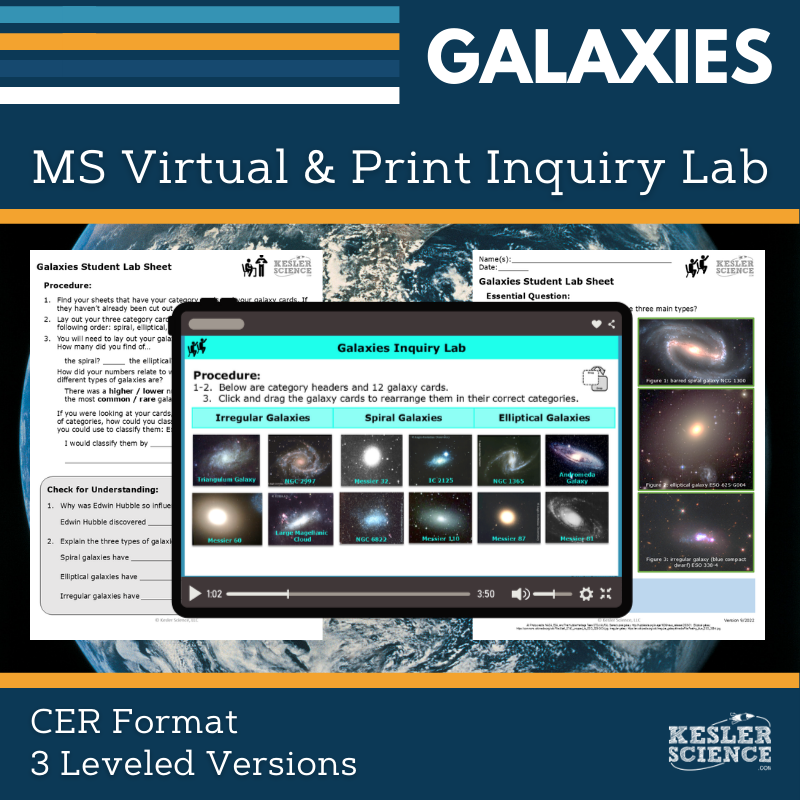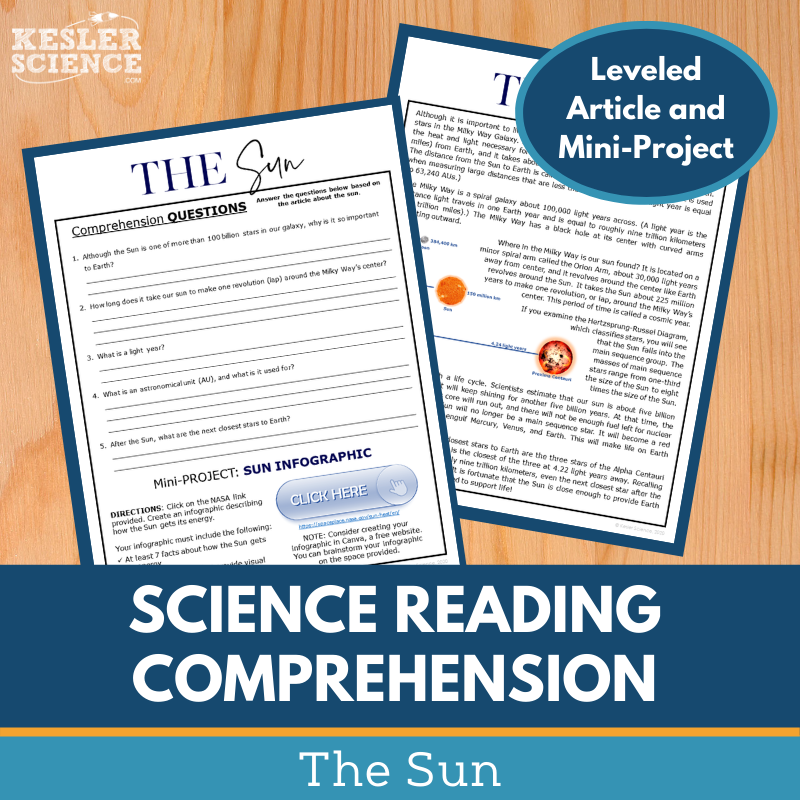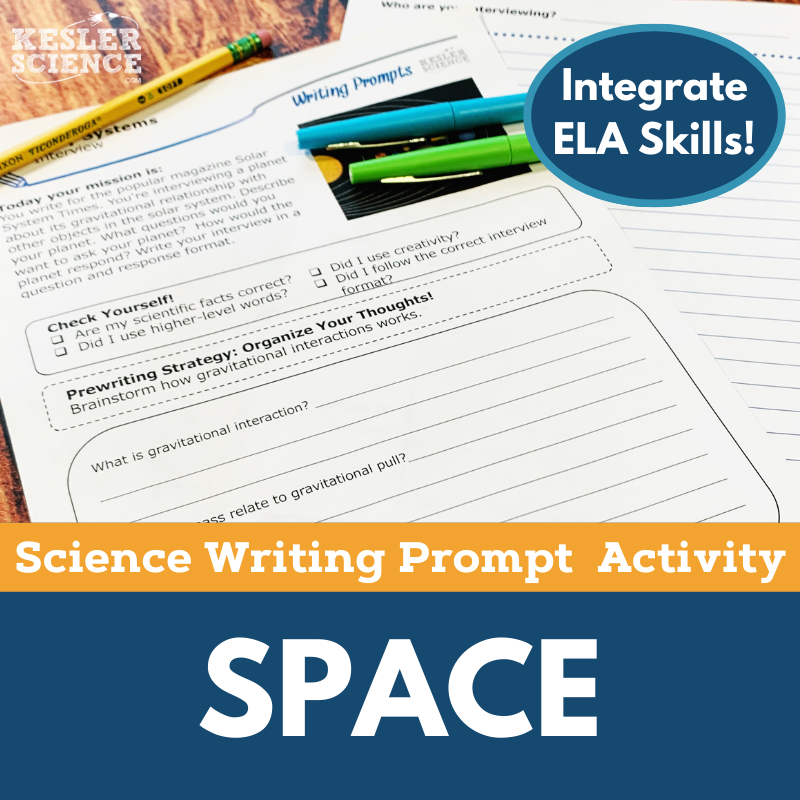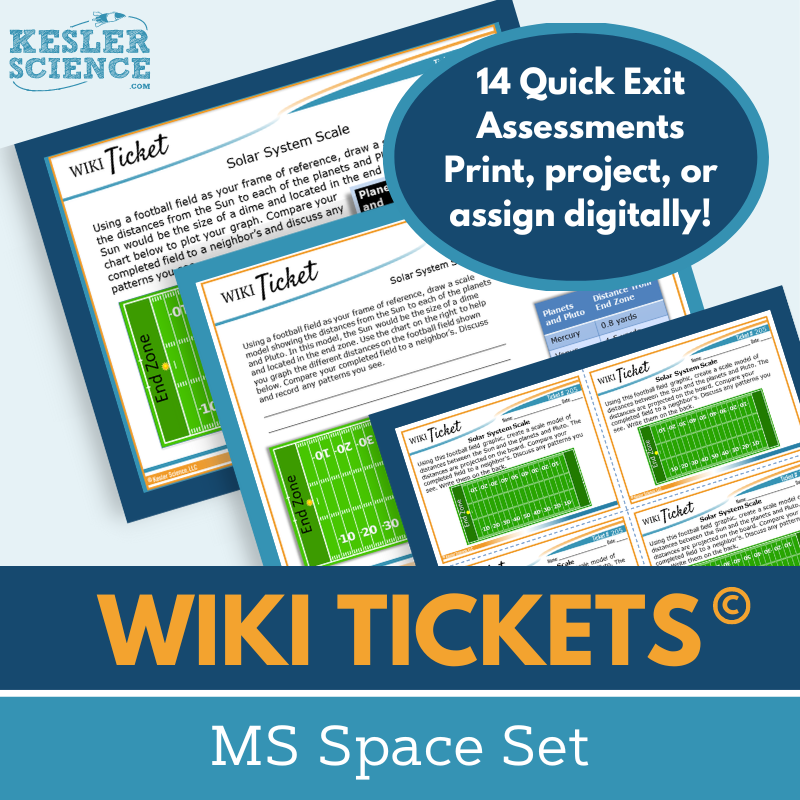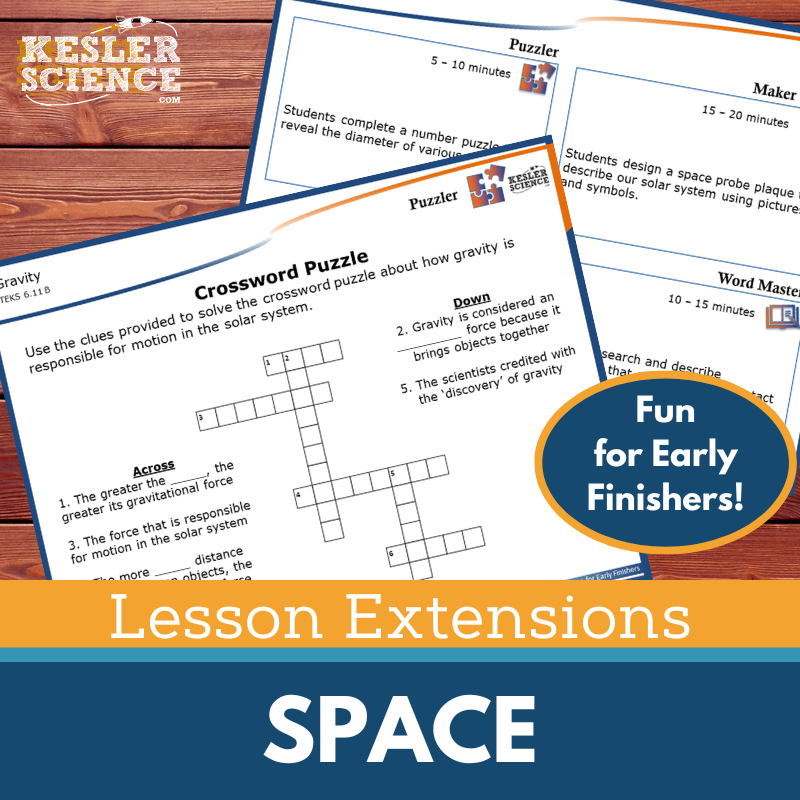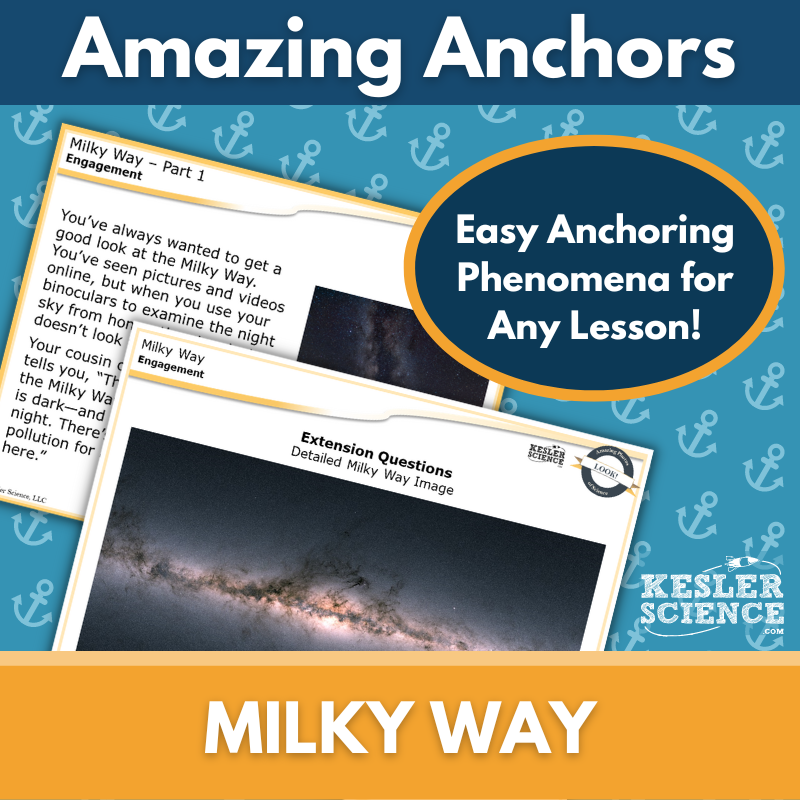Galaxies and Light Years Activities for Middle School Science
The Kesler Science Galaxies and Light Years 5E Lesson offers a comprehensive, low-prep unit that guides middle school students through the structure of galaxies and the use of light years to measure astronomical distances. The resources below will give students a comprehensive understanding of galaxies and light years. All of the following materials are also included in the Kesler Science Membership.
The Kesler Science Galaxies and Light Years Complete 5E Lesson is designed to provide a comprehensive, student-led exploration of galaxies and light years with minimal prep. It offers all the necessary materials for a multi-day lesson, focusing on essential questions such as the three types of galaxies and how light years measure distance in the universe. The lesson is differentiated to support a variety of learners, with both printable and digital formats, and includes resources in English and Spanish.
The lesson follows the 5E model: Engagement, Exploration, Explanation, Elaboration, and Evaluation. Students engage with objectives and vocabulary through activities and class discussions. In the Exploration phase, they experience nine differentiated stations, each offering input stations like hands-on demos, reading, research, and videos, and output stations for organizing, illustrating, and assessing their knowledge. A bonus challenge station offers additional opportunities for advanced learners.
For the Explanation and Elaboration stages, the lesson includes editable PowerPoints, interactive notebooks, and note-taking templates for differentiated learning. Students can extend their learning through student-choice projects, and evaluation is supported with standards-aligned assessments and review questions. The lesson is adaptable for both in-person and virtual learning environments.
The Kesler Science Galaxies and Light Years Complete 5E Lesson is designed to provide a comprehensive, student-led exploration of galaxies and light years with minimal prep. It offers all the necessary materials for a multi-day lesson, focusing on essential questions such as the three types of galaxies and how light years measure distance in the universe. The lesson is differentiated to support a variety of learners, with both printable and digital formats, and includes resources in English and Spanish.
The lesson follows the 5E model: Engagement, Exploration, Explanation, Elaboration, and Evaluation. Students engage with objectives and vocabulary through activities and class discussions. In the Exploration phase, they experience nine differentiated stations, each offering input stations like hands-on demos, reading, research, and videos, and output stations for organizing, illustrating, and assessing their knowledge. A bonus challenge station offers additional opportunities for advanced learners.
For the Explanation and Elaboration stages, the lesson includes editable PowerPoints, interactive notebooks, and note-taking templates for differentiated learning. Students can extend their learning through student-choice projects, and evaluation is supported with standards-aligned assessments and review questions. The lesson is adaptable for both in-person and virtual learning environments.
The Kesler Science Galaxies and Light Years Station Lab is a modular, student-led activity designed to engage middle school students in learning about galaxies and the vast distances in space. This low-prep resource allows students to explore key concepts independently through inquiry-based tasks, fostering curiosity and understanding of the universe.
The station lab includes eight differentiated activities, with a ninth challenge station for advanced learners, providing personalized learning opportunities for all students. Input stations like "Explore It!", "Research It!", "Read It!", and "Watch It!" offer multimodal approaches to introducing new concepts, while Output stations such as "Organize It!", "Illustrate It!", "Write It!", and "Assess It!" allow students to demonstrate their knowledge through various methods.
This adaptable resource is perfect for both in-person and virtual learning environments, offering all necessary materials, signage, and task cards. Whether working with hands-on manipulatives or digital tools, students can actively engage in understanding galaxies and light years, reinforcing their learning through creative and interactive activities.
The Kesler Science Galaxies and Light Years Station Lab is a modular, student-led activity designed to engage middle school students in learning about galaxies and the vast distances in space. This low-prep resource allows students to explore key concepts independently through inquiry-based tasks, fostering curiosity and understanding of the universe.
The station lab includes eight differentiated activities, with a ninth challenge station for advanced learners, providing personalized learning opportunities for all students. Input stations like "Explore It!", "Research It!", "Read It!", and "Watch It!" offer multimodal approaches to introducing new concepts, while Output stations such as "Organize It!", "Illustrate It!", "Write It!", and "Assess It!" allow students to demonstrate their knowledge through various methods.
This adaptable resource is perfect for both in-person and virtual learning environments, offering all necessary materials, signage, and task cards. Whether working with hands-on manipulatives or digital tools, students can actively engage in understanding galaxies and light years, reinforcing their learning through creative and interactive activities.
The Kesler Science Galaxies and Light Years Student Choice Projects lesson empowers middle school students to select a project that aligns with their preferred output style. The project page offers six different options and a “design your own” project, all supported by a grading rubric for assessments by teachers, peers, or the students themselves. This approach encourages flexibility and creativity, allowing students to demonstrate their learning in personalized ways.
This resource includes nine project choices along with an editable rubric to assess vocabulary, concepts, clarity, and presentation. It also provides differentiated options to meet the needs of all learners, with modified projects for students requiring extra support and challenging assignments for advanced learners. Teachers can adjust the rubric as needed to suit their grading preferences.
The Student Choice Projects are designed to be flexible, using common classroom supplies such as paper, markers, and scissors. Many projects can also be completed digitally, offering an easy way to integrate technology. Whether crafting models or creating digital presentations, students will have a chance to explore galaxies and light years in a creative, engaging way.
The Kesler Science Galaxies and Light Years Student Choice Projects lesson empowers middle school students to select a project that aligns with their preferred output style. The project page offers six different options and a “design your own” project, all supported by a grading rubric for assessments by teachers, peers, or the students themselves. This approach encourages flexibility and creativity, allowing students to demonstrate their learning in personalized ways.
This resource includes nine project choices along with an editable rubric to assess vocabulary, concepts, clarity, and presentation. It also provides differentiated options to meet the needs of all learners, with modified projects for students requiring extra support and challenging assignments for advanced learners. Teachers can adjust the rubric as needed to suit their grading preferences.
The Student Choice Projects are designed to be flexible, using common classroom supplies such as paper, markers, and scissors. Many projects can also be completed digitally, offering an easy way to integrate technology. Whether crafting models or creating digital presentations, students will have a chance to explore galaxies and light years in a creative, engaging way.
The Kesler Science Space Science Interactive Notebook is an engaging resource for teachers looking to create interactive learning experiences for their students. It includes both print and digital versions, making it perfect for traditional classrooms, 1:1 environments, or distance learning.
The bundle covers key space science topics such as asteroids, meteors, and comets, the Big Bang theory, eclipses, the electromagnetic spectrum, galaxies, and more. The digital version features a PowerPoint interactive notebook, which can be uploaded to Google Slides or learning management systems like MS Teams or Canvas. Reflection pages and space for students to take notes are included, along with a teacher answer key and modified versions for students with accommodations.
The print version provides a full set of blank templates for students, pre-filled templates for those needing modifications, and color photos to illustrate how each template should be used. This bundle is designed to support differentiated learning and keep students engaged in key space science concepts.
The Kesler Science Space Science Interactive Notebook is an engaging resource for teachers looking to create interactive learning experiences for their students. It includes both print and digital versions, making it perfect for traditional classrooms, 1:1 environments, or distance learning.
The bundle covers key space science topics such as asteroids, meteors, and comets, the Big Bang theory, eclipses, the electromagnetic spectrum, galaxies, and more. The digital version features a PowerPoint interactive notebook, which can be uploaded to Google Slides or learning management systems like MS Teams or Canvas. Reflection pages and space for students to take notes are included, along with a teacher answer key and modified versions for students with accommodations.
The print version provides a full set of blank templates for students, pre-filled templates for those needing modifications, and color photos to illustrate how each template should be used. This bundle is designed to support differentiated learning and keep students engaged in key space science concepts.
The Galaxies Inquiry Lab aligns with NGSS standards by engaging students in sorting galaxies into three main types: spiral, elliptical, and irregular. This interactive lab is available in both digital and print formats and includes comprehension questions, C.E.R. prompts, and a reflection section. Whether using the hands-on or virtual version, students explore real astronomical data and construct understanding through analysis and model creation.
This lab includes three differentiated levels—dependent, modified, and independent—to support all learners. The dependent version provides guided inquiry with procedural support, while the modified version includes structured scaffolding such as sentence stems and multiple-choice questions. The independent level is student-directed and encourages learners to build their own galaxy models and draw conclusions with minimal guidance.
The lab is fully editable and compatible with Google Slides, offering flexibility and convenience. It comes with teacher resource pages, answer keys, and materials lists. Students can complete the lab using galaxy cards and model-making supplies in print, or explore the same concepts through interactive digital slides with no materials needed.
The Galaxies Inquiry Lab aligns with NGSS standards by engaging students in sorting galaxies into three main types: spiral, elliptical, and irregular. This interactive lab is available in both digital and print formats and includes comprehension questions, C.E.R. prompts, and a reflection section. Whether using the hands-on or virtual version, students explore real astronomical data and construct understanding through analysis and model creation.
This lab includes three differentiated levels—dependent, modified, and independent—to support all learners. The dependent version provides guided inquiry with procedural support, while the modified version includes structured scaffolding such as sentence stems and multiple-choice questions. The independent level is student-directed and encourages learners to build their own galaxy models and draw conclusions with minimal guidance.
The lab is fully editable and compatible with Google Slides, offering flexibility and convenience. It comes with teacher resource pages, answer keys, and materials lists. Students can complete the lab using galaxy cards and model-making supplies in print, or explore the same concepts through interactive digital slides with no materials needed.
In this engaging middle school science lesson, students explore the Sun by reading a nonfiction article focused on its location in the universe and its classification as a star. After reading, students answer comprehension questions and create an infographic to demonstrate their understanding of the Sun's characteristics. The lesson is designed to support science literacy and reading comprehension through an interactive, standards-aligned format.
The resource includes two leveled reading passages (Lexile 1100–1300), each with 5–7 comprehension questions and a hands-on mini-project. A Cornell notes template is also provided, and all materials feature visually engaging graphics that are printable in grayscale. Designed for grades 6–8 (and advanced 5th graders), this resource helps students build content knowledge and analytical skills in a format that accommodates various learning styles.
The digital files are compatible with platforms like Google Classroom, MS Teams, Schoology, and Canvas, making the lesson ideal for virtual or in-person instruction. Teachers can assign the passage for whole-class activities, absent students, ISS, extra credit, or sub plans. The article supports routines, promotes classroom discussion, and encourages textual analysis, offering flexible options to build students’ science comprehension.
In this engaging middle school science lesson, students explore the Sun by reading a nonfiction article focused on its location in the universe and its classification as a star. After reading, students answer comprehension questions and create an infographic to demonstrate their understanding of the Sun's characteristics. The lesson is designed to support science literacy and reading comprehension through an interactive, standards-aligned format.
The resource includes two leveled reading passages (Lexile 1100–1300), each with 5–7 comprehension questions and a hands-on mini-project. A Cornell notes template is also provided, and all materials feature visually engaging graphics that are printable in grayscale. Designed for grades 6–8 (and advanced 5th graders), this resource helps students build content knowledge and analytical skills in a format that accommodates various learning styles.
The digital files are compatible with platforms like Google Classroom, MS Teams, Schoology, and Canvas, making the lesson ideal for virtual or in-person instruction. Teachers can assign the passage for whole-class activities, absent students, ISS, extra credit, or sub plans. The article supports routines, promotes classroom discussion, and encourages textual analysis, offering flexible options to build students’ science comprehension.
The Space Science Writing Activity engages middle school students in a creative narrative exercise that reinforces their earth science knowledge through writing. Designed for both print and digital use, this low-prep, student-centered activity encourages science reasoning and exploration while allowing flexibility for in-person or virtual learning. With 145 TEKS- and NGSS-aligned topics available, it works well as a review or elaboration task.
Each writing prompt includes a range of resources: teacher directions with rubrics and project ideas, full-sized and half-sheet student handouts for pre-writing and self-check, and a digital version in PowerPoint or Google Slides. These materials are ideal for integration into interactive notebooks or writing journals and are easy to display on bulletin boards or compile into student anthologies.
This activity supports various instructional needs, including cross-curricular integration, pre-test assessments, student choice projects, and differentiation. It can also be used for make-up work, extra credit, TELPAS samples, or as an enrichment option for early finishers. Students should already have background knowledge or access to research materials on the topic.
The Space Science Writing Activity engages middle school students in a creative narrative exercise that reinforces their earth science knowledge through writing. Designed for both print and digital use, this low-prep, student-centered activity encourages science reasoning and exploration while allowing flexibility for in-person or virtual learning. With 145 TEKS- and NGSS-aligned topics available, it works well as a review or elaboration task.
Each writing prompt includes a range of resources: teacher directions with rubrics and project ideas, full-sized and half-sheet student handouts for pre-writing and self-check, and a digital version in PowerPoint or Google Slides. These materials are ideal for integration into interactive notebooks or writing journals and are easy to display on bulletin boards or compile into student anthologies.
This activity supports various instructional needs, including cross-curricular integration, pre-test assessments, student choice projects, and differentiation. It can also be used for make-up work, extra credit, TELPAS samples, or as an enrichment option for early finishers. Students should already have background knowledge or access to research materials on the topic.
The Kesler Science Space WIKI Tickets are engaging formative assessments designed for 6th-8th grade science topics, offering multiple flexible formats to check student understanding. Each topic in the Space Set includes five versions: full-screen display, three handout sizes (full, split, and quarter-page), and a digital interactive option that can be used as an editable PowerPoint or Google Slides file.
These assessments are aligned with NGSS and TEKS middle school science standards, with some topics featuring multiple tickets. Each set also includes a bonus table of contents file to show standard alignment, ensuring a comprehensive understanding of the covered topics.
Perfect for both in-class and remote learning, WIKI Tickets can be used as exit tickets, bellringers, or anytime you need to gauge students' progress. Whether projected on a screen or completed digitally, these colorful and engaging assessments provide valuable insight into student comprehension of key space science topics such as the lunar cycle, solar system properties, and space exploration.
The Kesler Science Space WIKI Tickets are engaging formative assessments designed for 6th-8th grade science topics, offering multiple flexible formats to check student understanding. Each topic in the Space Set includes five versions: full-screen display, three handout sizes (full, split, and quarter-page), and a digital interactive option that can be used as an editable PowerPoint or Google Slides file.
These assessments are aligned with NGSS and TEKS middle school science standards, with some topics featuring multiple tickets. Each set also includes a bonus table of contents file to show standard alignment, ensuring a comprehensive understanding of the covered topics.
Perfect for both in-class and remote learning, WIKI Tickets can be used as exit tickets, bellringers, or anytime you need to gauge students' progress. Whether projected on a screen or completed digitally, these colorful and engaging assessments provide valuable insight into student comprehension of key space science topics such as the lunar cycle, solar system properties, and space exploration.
The Kesler Science Space Lesson Extensions provide engaging activities designed to challenge fast finishers and deepen student learning. These critical thinking tasks are connected to NGSS and TEKS space standards, offering rigorous but fun opportunities to explore topics in greater depth. With activities like puzzles, hands-on maker space tasks, tech connections, and creative word writing, these extensions promote STEAM skills and digital literacy.
The Lesson Extensions are structured to provide flexible support for teachers, with clear directions, answer keys, and both digital and paper versions. These materials help reinforce the lesson’s core concepts while offering ways to engage students during testing or other gaps in the schedule.
Perfect for independent learners, these activities push students to apply their knowledge creatively while connecting it to real-world applications. The extensions cover a variety of space science topics, including gravity, space travel, and the lunar cycle, providing additional challenges that extend the learning experience beyond the standard lesson.
The Kesler Science Space Lesson Extensions provide engaging activities designed to challenge fast finishers and deepen student learning. These critical thinking tasks are connected to NGSS and TEKS space standards, offering rigorous but fun opportunities to explore topics in greater depth. With activities like puzzles, hands-on maker space tasks, tech connections, and creative word writing, these extensions promote STEAM skills and digital literacy.
The Lesson Extensions are structured to provide flexible support for teachers, with clear directions, answer keys, and both digital and paper versions. These materials help reinforce the lesson’s core concepts while offering ways to engage students during testing or other gaps in the schedule.
Perfect for independent learners, these activities push students to apply their knowledge creatively while connecting it to real-world applications. The extensions cover a variety of space science topics, including gravity, space travel, and the lunar cycle, providing additional challenges that extend the learning experience beyond the standard lesson.
This Amazing Anchors Phenomenon Lesson introduces and reinforces the concept of galaxies through real-world connections. It begins with an engaging introductory reading focused on the Milky Way, accompanied by comprehension and extension questions to spark student curiosity. The follow-up explanatory reading breaks down the science behind galaxies in a clear, approachable way, with additional questions to support understanding and critical thinking.
Aligned with TEKS standards, this no-prep resource includes teacher directions, answer keys, and both digital and print versions for classroom flexibility. Materials include full-page projection slides, editable PowerPoints for LMS platforms, and printable half- or full-sheet handouts for interactive notebooks. The lesson also comes with a differentiated version that provides sentence starters and simplified language to support diverse learners.
Designed to bookend a main lesson, this resource is ideal for the Engagement and Elaborate stages of the 5E Model. Whether used in-person or virtually, it provides a meaningful way for students to explore galaxies through accessible readings and thoughtful questions that deepen science literacy.
This Amazing Anchors Phenomenon Lesson introduces and reinforces the concept of galaxies through real-world connections. It begins with an engaging introductory reading focused on the Milky Way, accompanied by comprehension and extension questions to spark student curiosity. The follow-up explanatory reading breaks down the science behind galaxies in a clear, approachable way, with additional questions to support understanding and critical thinking.
Aligned with TEKS standards, this no-prep resource includes teacher directions, answer keys, and both digital and print versions for classroom flexibility. Materials include full-page projection slides, editable PowerPoints for LMS platforms, and printable half- or full-sheet handouts for interactive notebooks. The lesson also comes with a differentiated version that provides sentence starters and simplified language to support diverse learners.
Designed to bookend a main lesson, this resource is ideal for the Engagement and Elaborate stages of the 5E Model. Whether used in-person or virtually, it provides a meaningful way for students to explore galaxies through accessible readings and thoughtful questions that deepen science literacy.
Year-Round Resources
These year-round activities will increase your students' understanding of many middle school science topics. All of these activities are also included in the Kesler Science Membership.
Visual Data & Graphing
You're not alone if your students struggle with understanding graphs, charts, and tables. It's a skill that takes an enormous amount of practice. This resource will help students build a strong foundation in analyzing data and creating their own data visualizations.
Bell Ringers and Warm-Ups
These middle school science bell ringers are an excellent way to engage your students as soon as they walk into your classroom. This comprehensive FULL YEAR resource includes everything you need to start off each science class with an interesting warm-up activity.
Review Board Games
Each game board has been carefully designed to keep students engaged. There are 10 different action spaces on each board and dozens of question cards. All of the actions are related to science concepts and keep the students motivated throughout the game.
Each game is ready to play. Simply print out the board and the cards and let the students enjoy reviewing nine different units.
Essential Questions
Below are the essential questions associated with the lessons and activities included in this unit. This topic is only one of more than 100 middle school science topics included in the Kesler Science Membership.
-
Can you describe the three main types of galaxies in the universe?
-
Can you model how light years measure distances in the universe?
Kesler Science Membership
Imagine never having to search for another middle school science lesson again. The membership gives you access to ALL of the Kesler Science products in one place (Yes, including everything above).
Say goodbye to long hours of lesson prep.

